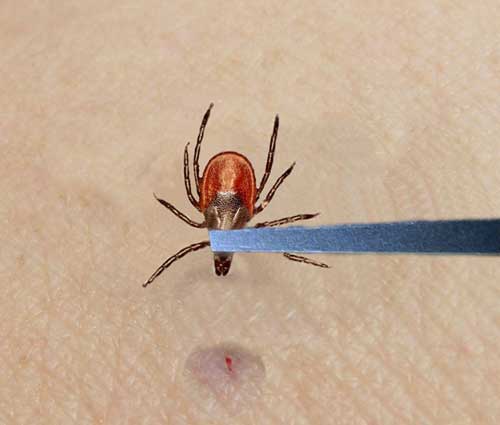It’s the beginning of summer in the northern hemisphere and tick season is well underway in North America and Europe. With the warmer weather enticing us outside, it’s a perfect time for a refresher on how to prevent tick bites.
Ticks are small insects in the spider family that feed on the blood of animals (including humans). They are found in many parts of the world in forested areas, tall grass, bushes, and even city parks. If you’re planning a camping trip, hike, safari, or other backwoods adventure, you should know how to prevent tick bites. Here are a few simple steps you can take:
An ounce of prevention
Before you go out:
• Wear a light-coloured, long-sleeved shirt and pants, and closed-toed shoes.
• Tuck your pants into your socks. (It looks silly but it works!)
• Use an insect repellent with 20-30% DEET or 20% Picaridin on exposed skin.
• If you can, treat your clothes and gear with permethrin. (Note that permethrin is not available in Canada.)
While you’re outside:
• Stick to the centre of the trail.
• Avoid brushing against tall grass.
Before you enter a building:
• Check your clothes, skin, pets, and gear for ticks. Be meticulous – ticks are tiny!
• Shower or bathe to wash away any loose ticks that you may have missed.
Under your skin: How to remove ticks

• If you find a tick attached to you, remove it right away.
• Use tweezers to grasp the tick’s head and mouth parts.
• Pull the tick away from the skin in a perpendicular direction. (This video shows how to remove a tick with tweezers.)
• Wash the bite thoroughly with soap and water or alcohol.
• Keep the tick in a plastic bag and submit it to your health provider for testing. This will determine if you need to be treated for Lyme disease or other tick-borne illnesses. It also helps public health agencies monitor the spread of these illnesses.
Keeping an eye on the bull’s-eye rash
In North America, Lyme disease is a growing problem. Lyme disease is caused by Borrelia burgdoferi bacteria transmitted by infected ticks (typically immature ticks called nymphs). Recent data shows that climate change is allowing ticks to spread further north and become established in new areas. Urban sprawl is also bringing people closer to wooded areas where deer, mice, and the ticks that feed on them live. Luckily, researchers are exploring new ways to control tick populations and prevent the spread of tick-borne illnesses. Awareness campaigns are also helping people prevent tick bites and recognize the symptoms of Lyme disease.
Some people with Lyme disease get a small bump and rash at the site of the bite, which expands to a wider, circular red patch (called a bull’s-eye rash). Symptoms like fever, headache, and muscle and joint pain can be easily mistaken for other illnesses. As a result, Lyme disease is often misdiagnosed for common illnesses like the flu.
If treated promptly, Lyme disease can usually be cured with antibiotics in two to four weeks. If left untreated, it can cause chronic problems like heart palpitations, sleep disturbance, arthritis, and short-term memory loss. Some people don’t have any symptoms in the early stage of Lyme disease, so you should contact your healthcare practitioner immediately if you suspect you’ve been bitten by a tick.
Ticks around the world
Unfortunately, ticks can transmit more than just Lyme disease. Tick-borne illnesses like African tick-bite fever, Mediterranean spotted fever, and Rocky Mountain spotted fever are a few of the tick-borne infections that can affect travellers.
Tick-borne encephalitis (TBE) is a risk to campers, hikers, and hunters in parts of Europe, central Asia, and east Asia. (A vaccine against TBE is available in affected countries – if you’re planning outdoor activities in an area with TBE, an IAMAT doctor can help you get vaccinated when you arrive.) Check IAMAT’s Country Health Advice to find out if there have been any recent cases in the countries you’re visiting.
Daphne Hendsbee, IAMAT’s Communications and Marketing Specialist, strives to present complex health information in a way that is concise, accurate, and easy to understand. She is especially interested in global health and the social determinants of health.
Tullia Marcolongo is the Executive Director of IAMAT. Her goal is to communicate travel health issues in a relatable manner, giving travellers all the options available to them to make an informed choice. She is a member of the International Society of Travel Medicine (ISTM), the American Society of Tropical Medicine and Hygiene (ASTMH), and holds a Certificate in Travel Health.
IAMAT’s mission is to make the world a healthier place to travel by providing travellers with impartial health information and access to an international network of English-speaking doctors.
Add this article to your reading list



